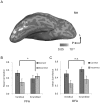The fusiform face area is engaged in holistic, not parts-based, representation of faces
- PMID: 22792301
- PMCID: PMC3391267
- DOI: 10.1371/journal.pone.0040390
The fusiform face area is engaged in holistic, not parts-based, representation of faces
Abstract
Numerous studies with functional magnetic resonance imaging have shown that the fusiform face area (FFA) in the human brain plays a key role in face perception. Recent studies have found that both the featural information of faces (e.g., eyes, nose, and mouth) and the configural information of faces (i.e., spatial relation among features) are encoded in the FFA. However, little is known about whether the featural information is encoded independent of or combined with the configural information in the FFA. Here we used multi-voxel pattern analysis to examine holistic representation of faces in the FFA by correlating spatial patterns of activation with behavioral performance in discriminating face parts with face configurations either present or absent. Behaviorally, the absence of face configurations (versus presence) impaired discrimination of face parts, suggesting a holistic representation in the brain. Neurally, spatial patterns of activation in the FFA were more similar among correct than incorrect trials only when face parts were presented in a veridical face configuration. In contrast, spatial patterns of activation in the occipital face area, as well as the object-selective lateral occipital complex, were more similar among correct than incorrect trials regardless of the presence of veridical face configurations. This finding suggests that in the FFA faces are represented not on the basis of individual parts but in terms of the whole that emerges from the parts.
Conflict of interest statement
Figures




References
-
- Barton JJ, Press DZ, Keenan JP, O'Connor M. Lesions of the fusiform face area impair perception of facial configuration in prosopagnosia. Neurology. 2002;58:71–78. - PubMed
-
- Harris A, Aguirre GK. The representation of parts and wholes in face-selective cortex. J Cogn Neurosci. 2008;20:863–878. - PubMed
Publication types
MeSH terms
LinkOut - more resources
Full Text Sources

